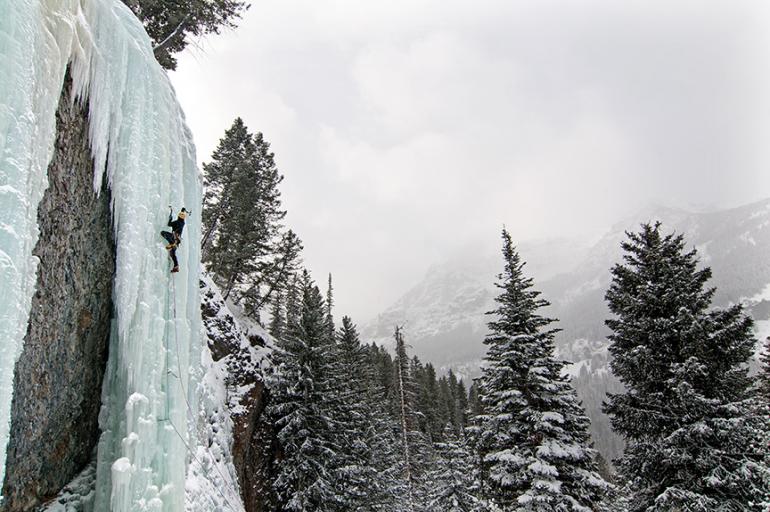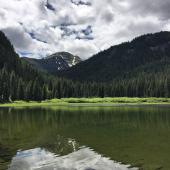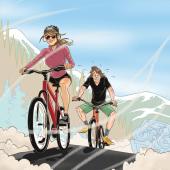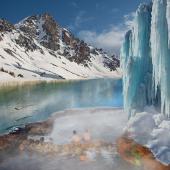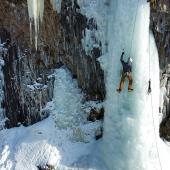Anchored by Ice
Two decades of the BIF.
In 2016 the Bozeman Ice Festival turned 20. It has grown from a rag-tag effort to sell a few pairs of crampons over Christmas to one of the largest and most innovative ice-climbing event in the world. Here’s how we got there.
A Tale of Two Fests
In the early 1990s, Hyalite Canyon had a growing reputation for some of the best winter routes in North America, and people around the country were eager to learn how to climb frozen waterfalls with ice axes in their hands and crampons on their feet.
In 1995, Northern Lights, an outdoor store in Bozeman, hosted a gear demo just after Thanksgiving, giving plenty of time for ice climbs to freeze before Hyalite Rd. became impassable with snow. Hyalite wasn’t plowed regularly back then, and driving to the ice routes was a gamble at best. “There wasn’t any ice-climbing gear to rent,” recalls Joel Lee, an employee of Northern Lights at the time. “We would get a little gear on loan from the manufacturers with staff providing instruction to expose the community to the sport.” Lee left Northern Lights in 1996 to join a new climbing store, Barrel Mountaineering, and envisioned the first real climbing festival in Bozeman. He invited three prominent climbers to teach clinics and present slideshows—Bozeman legend Jack Tackle and two pioneering climbers from Canada, Joe Josephson and Barry Blanchard.
These athletes, and those that followed, like Mark Twight, Will Gadd, and Stevie Haston, provided an international flair for the festival and began what would become a trademark experience for the Barrel Ice Festival. Festival participants could actually climb with magazine heroes, inspiring the next generation of ice climbers. “If you haven’t seen any of these guys climb, you don’t know whether it’s within your realm of possibility,” explains Lee. “But when you have them climb and teach alongside beginners, it humanizes the sport. It makes it much more achievable.”
With Lee at the helm, the Barrel Ice Festival became one of the premier ice festivals in the country. The Northern Lights demo also grew, but balancing the logistics of two competing events, the unpredictability of consistent cold, and early road-impassibility was challenging. “In the early days of the festival it was always a bit of a wildcard,” remembers Jack Tackle. “You had no guarantee the ice would be in or that the snow would hold off.” Greg Caracciolo, a manger at Northern Lights for many years, recalls the effort it took to ensure the events could run each year. “There were lots of mornings I’d drive up there to check on the ice or to bust open the road after a snow. Occasionally, there wasn’t enough early-season ice and we’d risk moving the dates, hoping the road wouldn’t blow shut.”
Ice fest clinics kickin' and steppin' at G1. Photo by Bob Allen / MT 360
Access Increases
In 2006, travel planning by the Forest Service threatened to close the road to winter vehicular travel. After a decade of competing events, Barrel and Northern Lights agreed to work together to host one event, helping raise awareness about the impending access concerns. They joined forces with Josephson, who had since moved back to Bozeman, and together with Mike Cooperstein, owner of Montana Alpine Guides, organized the “new” Bozeman Ice Festival (BIF), set for the weekend after Thanksgiving.
That year, local guide Amy Bullard organized the first women’s-only clinic as part of the festival. Providing a supportive and encouraging setting in a previously male-dominated sport, the women’s clinic quickly became one of the most popular aspects of BIF. Kitty Calhoun, ice-climbing pioneer and co-owner of Chicks with Picks in Colorado, declared the BIF women’s clinic to be the “biggest and best one-day women’s clinic in the country.”
Even while it grew in popularity, BIF struggled to find a suitable in-town venue for evening events. The Lindley Center and Baxter Ballroom worked for the first few years, before moving to the American Legion downtown. In 2009, the Legion was leveled in a gas explosion that rocked downtown Bozeman, and the festival was once again homeless.
There was another growing problem: consistent cold was arriving later every year, while unpredictable early-season snowstorms would threaten access to the end of Hyalite Rd. where all of the ice climbs are concentrated. “Hyalite had a great reputation for lots of good routes in a compact zone, but the road always created a huge question-mark about access once the snow really flies,” recalls Josephson.
Since the 1970s, the Forest Service had plowed the road through Hyalite a handful of times. There was interest, but reliable funding or organizing capacity either fell through or wasn’t available. After six years of outreach by the Southwest Montana Climbers’ Coalition, Gallatin County joined the Forest Service in 2009 for a unique five-year cost-share agreement to test how road plowing might go. They agreed to occasionally plow the road to the end, dependent on funding.
With access to the end of the road less fuzzy, BIF moved to the second weekend in December and booked the Emerson Cultural Center for demos and slideshows. The Bozeman Ice Festival finally found a home.
Competitive Climbing
In 2007, Josephson envisioned a unique backcountry “competition” known as the Ice Breaker. Pairing a traveling professional climber with a Hyalite local, men’s and women’s teams would endeavor to climb as many pitches as they could in a single day. With a complex rating system based on difficulty and approach, teams would have to decide between scores of easy pitches versus a handful of test pieces. This friendly event became one of the most sought-after climbing competitions in the world, with athletes coming from across North America and Europe. Sadly, during the 2009 event, legendary Canadian climber Guy Lacelle was killed when swept over a cliff from a small powder sluff. This remains the only ice-climbing death in Hyalite and inspired the Guy Lacelle Hyalite Service Award, given every year to commemorate Guy’s spirit, humanitarian legacy, and lifelong commitment to ice climbing and service to others.
With the overall capacity in the canyon limited by its wilderness setting, and with clinics consistently selling out, BIF continued to look for a way to develop the in-town events and make the festival more spectator-friendly. With a growing movement to establish ice climbing as an Olympic sport, BIF made it a goal to host a World Cup–caliber competition.
In 2012, BIF erected an 80-foot-high artificial ice-climbing structure on the Emerson lawn. This grassroots competition attracted world champion climbers like Canadian Will Gadd and Italian Angelica Rainer. The next year, the event grew into the internationally sanctioned (UIAA) North America Ice Climbing Championships. The level of difficulty grew and so did the crowd, with hundreds of spectators cheering on athletes from around the world. In 2014, Bozeman hosted a UIAA Ice Climbing World Cup, one of only five across the globe, which attracted over 1,000 people.
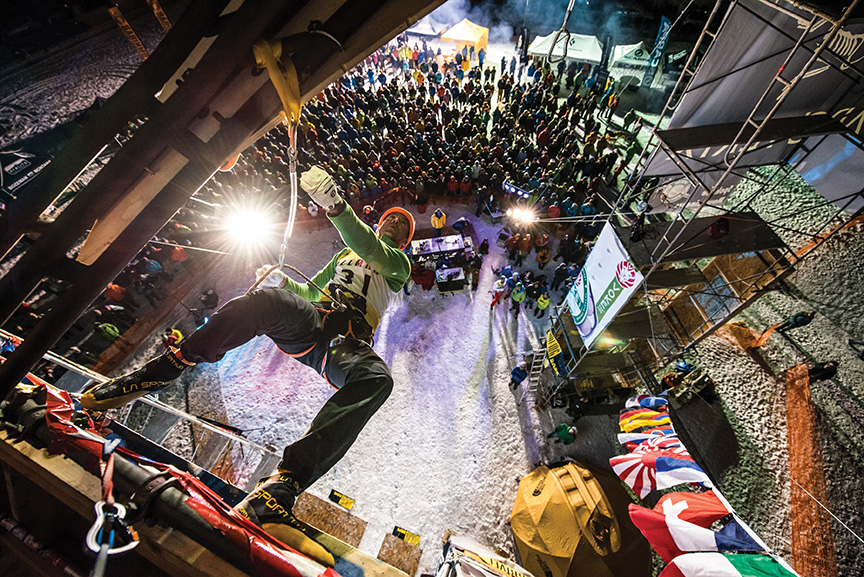 Spectators gather to watch world-class competition
Spectators gather to watch world-class competition
The fest moved to the County Fairgrounds in 2015, where a catastrophic hurricane-force storm destroyed the climbing structure just weeks prior to the event. The ice-climbing, Bozeman, and Big Sky communities rallied and were able to raise the funds to rebuild, hosting the Bozeman World Cup right on schedule—2,000 spectators showed up. Due to the cost and effort to build an artificial structure from scratch each year, the World Cup will take a year off for 2016, returning in 2017. Bozeman will continue to host the event every two years, leading up to its inclusion as a full medal sport in upcoming Winter Olympics.
Checking out some demo gear at the Emerson. Photo by Bob Allen / MT 360
The 20th Anniversary
After 20 years of evolution and growth, the reason for the festival remains unchanged. The primary mission is to promote the sport of ice climbing, in all its forms, to people of all ages and abilities; to educate ice climbers about necessary skills and safe techniques; and introduce climbers to cutting-edge equipment and clothing.
To celebrate two decades, the festival is bringing back the originals—Jack Tackle and Barry Blanchard—to join director and emcee Joe Josephson. Blanchard can hardly contain his excitement: “I’m looking forward to seeing my old and dear friends and to meeting a whole bunch of new folks who are keen to learn about ice climbing.”
The 20th Anniversary kicks off “Ice Fest Week” during the Bozeman Christmas Stroll on December 3, with a special display at the Lark hotel. Hyalite Canyon events will feature a unique two-day self-rescue clinic to benefit the Alex Lowe Charitable Foundation, and expanded women’s-only and youth clinics. BIF evening events include a keynote by Bozeman legend Jack Tackle; the exclusive announcement of the Mugs Stump Award, the premier climbing grant in America; and the recipient of the Guy Lacelle Hyalite Service Award.
New for 2016, BIF will host two showings of the Adventure Film Festival with a special introduction by the local drumming group Bear Canyon Singers and Bozeman High Native Dancers, now in their fourth year performing specially for the Bozeman Ice Festival. The Adventure Film Festival represents an important evolution for the festival. As Josephson says, “BIF has changed lives on the ice for a generation. The spirit found in the Adventure Film Festival represents our connection to the value of storytelling. Parallel to our contributions to an emerging Olympic movement for competitive ice climbing, we envision the Adventure Film Festival as being the spark for another 20 years of inspiration for a new generation to tell their stories and change lives.”

